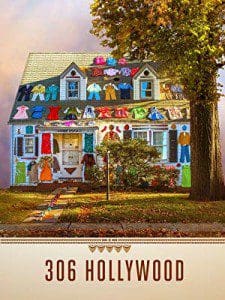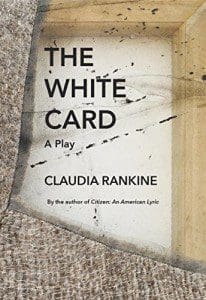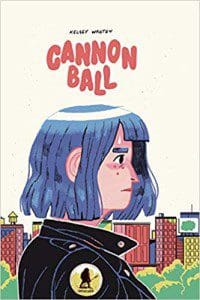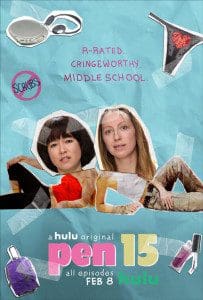April feels as though it’s come in gone in a flash (though we did make appearances at the Orcas Island Literary Festival and the Los Angeles Times Festival of Books), but we’re taking time out to share what ZYZZYVA recommends this month—a roundup of the works we’ve been reading, watching, and listening to:
 Josh Korwin, Graphic Designer: “If you didn’t have the physical remains of the past, the question would be whether it existed.” 2018’s 306 Hollywood (directed by Elan & Jonathan Bogarín), billed as a “magical realist documentary,” is otherworldly, yet perfectly ordinary. On the surface, the film revolves around the life and death of the filmmakers’ grandmother, Annette Ontell, and the ramshackle house she left behind. “Messy” would be putting it nicely (“This’ll be a shanda to show all this garbage!” Ontell remarks), but the Hillside, New Jersey house’s significance and inspirational role to the grandkids is contagious when seen through their wondering, childlike perspective. It’s a reminder of how when we’re young, anything can feel magical.
Josh Korwin, Graphic Designer: “If you didn’t have the physical remains of the past, the question would be whether it existed.” 2018’s 306 Hollywood (directed by Elan & Jonathan Bogarín), billed as a “magical realist documentary,” is otherworldly, yet perfectly ordinary. On the surface, the film revolves around the life and death of the filmmakers’ grandmother, Annette Ontell, and the ramshackle house she left behind. “Messy” would be putting it nicely (“This’ll be a shanda to show all this garbage!” Ontell remarks), but the Hillside, New Jersey house’s significance and inspirational role to the grandkids is contagious when seen through their wondering, childlike perspective. It’s a reminder of how when we’re young, anything can feel magical.
After her death, the Bogaríns decide “we’re turning grandma’s house into an archeological dig” before it is sold. This countdown premise provides a background rhythm for the film, which is otherwise a somewhat wandering meditation on memory, scale, and impermanence. Its rambling at times is forgivable, as a lively raconteur goes off on tangents while remaining utterly captivating. Not every story need be neatly told; along the dirt roads we find buried treasure.
The filmmakers have a peculiar fascination with the aesthetic of yesteryear, explicitly ogling type and lettering specimens from the past (swoon!). The opening and interstitial title cards primarily consist of hand-set letterpress prints by the talented designer/printers at Hammerpress, plus hand-lettering, foil stamped faux book covers, etc. They’re newly made artifacts in their own right, “imprints of time pressed into” the film itself.
Most spectacularly, the Bogaríns commissioned a tiny replica of their grandmother’s 1936 cottage, complete with its mid-century tacky-chic patterned wallpaper, wood paneling, and rose-pink tiled bathroom, all perfectly miniaturized. The exquisitely placed dollhouse toilet paper rolls and Saltines boxes add to the film’s Wes Andersonesque twee vibe, with a soupçon of I Like Killing Flies.
Can you bring someone back to life by examining their worldly possessions? Not entirely. But the Bogaríns’ elevation of household objects as archeological artifacts, shot reverently as though plinthed in the Metropolitan Museum, help us to remember, and to feel. Macro-lens textures of floral terry cloth and plastic CVS shopping bags are surprisingly gorgeous, and moving. Their Knolling and color groupings of office supplies into archaeological “catalogues” is bound to set off some ASMR for the obsessive compulsive designer types among us.
The film captures the specific cocktail of pain, joy, curiosity, learning, and grief that accompanies rummaging through a loved one’s house after they pass away, and the immense weight of all the stuff we carry around with us until it’s left to someone else to figure out.
This film hits particularly close to home for me. Ontell, in interviews filmed by Elan Bogarín over ten years, was a gem; she reminds me of my own sorely missed Jewish grandparents. As a people ever dispersed, our roots on this continent are extremely shallow. Our ancient heirlooms are lost, so Band-Aid tins full of pennies carry history in their place.
Conversations with an archaeologist, a fashion conservator, and an archivist at the Rockefeller estate contrast the lives of the important, famous, and wealthy from the lives of the anonymous and modest. Privilege leads to preservation (“we’re the winners so we get to tell the story that we want to tell”). But humanity transcends class. The Rockefeller archivist is asked, “is documenting your family’s history as important as documenting the history of the Rockefellers?” “Yes of course,” he replies, “my grandparents were hugely important. To make a qualitative judgment that they somehow didn’t have value, and so we’re not going to save a record of their existence, tells a kind of story that we don’t want to tell about this nation, which is that it’s only great and wealthy people who have value.”
 Casey Jong, Intern: Claudia Rankine’s The White Card is a concise and captivating two-scene play that begins at a dinner party for an artist, and ends in her art studio a year later. Rankine uses the creation and collection of fine art as a metaphor for the interrogation of our relationships with race and consumption of blackness.
Casey Jong, Intern: Claudia Rankine’s The White Card is a concise and captivating two-scene play that begins at a dinner party for an artist, and ends in her art studio a year later. Rankine uses the creation and collection of fine art as a metaphor for the interrogation of our relationships with race and consumption of blackness.
The play has only five characters, including artist Charlotte, a black woman in her forties being courted by a wealthy white art collector and his family. Rankine seamlessly and quickly crafts white characters who don’t fit the mold of overt racists or smug wealthy conservatives, and who, for that very reason, consider themselves to be on the “right side” of the racial injustices of history and of today. These collectors of “black death”, as Charlotte frames it, are able to put political and racialized artwork on their walls without ever engaging with the politics or the humanity of affected black people:
Look, I don’t want to think of the officer as a monster of Hulk Hogan or a demon or whatever and I don’t think you’re a monster, but his obsession with black people as criminals and yours with black people as victims are cut from the same cloth. Neither is human.
The dynamics between Charlotte and the collectors are complicated by both the transactional nature of their interactions, and also by the family’s fascination with Charlotte and other black figures like Venus and Serena Williams, Barack Obama, Ta-Nehisi Coates, and others. Their first conversations gesture at misplaced guilt and a fundamental misunderstanding of what they believe they’re fighting for. Their activist son also plays an interesting role, one that may feel familiar to and critical of many readers, as he understands much of what is wrong with America but continuously overlooks the nuance of the issues he is fighting.
By the end of the play, Charlotte’s experience at the dinner has changed her art and perspective dramatically, and she clearly plans to continue shifting the perspective of others with her own work. One of Charlotte’s greatest insights comes when father and son are fighting at the dinner table, each of them insisting on one specific dimension of the larger conversation: “All things can be true at the same time.” The power of this simple line, to me, is in the tough questions it invokes in the context of this play: How might we face the realities of racialized violence without commodifying and numbing ourselves to the harm done to black people? How can whiteness, not just blackness, be addressed?
 Katie O’Neill, Intern: This month, I especially enjoyed reading Kelsey Wroten’s Cannonball, a graphic novel depicting the exploits of Caroline Bertram, a recent art school graduate struggling to pursue her creative endeavors. The book is divided into three sections over distinct periods of time, following Caroline’s navigation of issues that plague many millenials.
Katie O’Neill, Intern: This month, I especially enjoyed reading Kelsey Wroten’s Cannonball, a graphic novel depicting the exploits of Caroline Bertram, a recent art school graduate struggling to pursue her creative endeavors. The book is divided into three sections over distinct periods of time, following Caroline’s navigation of issues that plague many millenials.
The first section focuses on her discontent with her minimum wage job, her struggles with binge drinking, and her inability to get published. She eventually reaches an artistic breakthrough and lands a book deal as a result of her obsession with a female wrestler, the Cannonball, who continues to serve as a source of inspiration throughout the novel. The second and third sections of the book follow her struggle to accept her success and her social circle’s uneasy adjustment to one of their own suddenly surpassing them. Even though she has finally achieved her artistic ambitions, Caroline still feels like a fraud and continues to struggle with issues like alcoholism.
The novel’s classic, incredibly vivid art significantly enhances the novel. Several of the full page spreads are particularly engaging, employing a swirling, almost psychedelic style that fully immerses the reader in Caroline’s inner turmoil. She is a sympathetic but somewhat self-absorbed character who is regularly cruel to her friends and acquaintances, and whose impossibly high standards ensure that she is never completely satisfied. She and most of her friends are queer, creating a welcome window into the lives of queer millennials. Her strained relationship with her father due to her queerness is especially compelling, as is her poor treatment of her love interests as a result of still being hung up on an old girlfriend. Although Caroline never achieves true happiness, she does manage to grow as both an individual and an artist, and provide a realistic, occasionally heartbreaking perspective on the millennial experience.
 Zack Ravas, Editorial Assistant: Hulu exclusive PEN15 chronicles the agony and ecstasy of middle school, based on the experiences of co-creators Maya Erskine and Anna Konkle. The twist is that both Erskine and Konkle – now comedians and writers in their early 30’s – play themselves in the show, with the rest of the cast comprised of age appropriate kids. There is something inherently subversive, you might even say perverse, in watching two 31 year-old women re-enact their most awkward and humiliating 7th grade moments opposite genuine adolescents. It can’t help but add an extra dimension, not to mention a cringe factor, to scenes where Maya and Anna fawn over a boy in their class or argue with their parents at the dinner table. Watching Maya and Anna navigate the social minefield of middle school circa the year 2000 – from trying to win tickets to an S Club 7 show off the radio, sneaking viewings of R-rated movie at sleepovers, and logging onto AOL Instant Messenger – can be as deeply uncomfortable as it is hilarious, a unique sensation that sets PEN15 apart from other streaming comedies.
Zack Ravas, Editorial Assistant: Hulu exclusive PEN15 chronicles the agony and ecstasy of middle school, based on the experiences of co-creators Maya Erskine and Anna Konkle. The twist is that both Erskine and Konkle – now comedians and writers in their early 30’s – play themselves in the show, with the rest of the cast comprised of age appropriate kids. There is something inherently subversive, you might even say perverse, in watching two 31 year-old women re-enact their most awkward and humiliating 7th grade moments opposite genuine adolescents. It can’t help but add an extra dimension, not to mention a cringe factor, to scenes where Maya and Anna fawn over a boy in their class or argue with their parents at the dinner table. Watching Maya and Anna navigate the social minefield of middle school circa the year 2000 – from trying to win tickets to an S Club 7 show off the radio, sneaking viewings of R-rated movie at sleepovers, and logging onto AOL Instant Messenger – can be as deeply uncomfortable as it is hilarious, a unique sensation that sets PEN15 apart from other streaming comedies.
For those viewers who came of age during the Clinton years, much of PEN15 should ring true – capturing the country’s last sliver of pre-9/11 innocence, from the N’Sync posters on Maya’s wall to the deafening crackle and hiss of a dial-up modem. Lest one think the show merely indulges in the soothing balm of nostalgia, an early episode tackles the prevalent racial stereotypes ingrained in Nineties culture (using the medium of the Spice Girls, of all things); and the entire season depicts some of the challenges Maya faces growing up in a multiracial household.
With so many shows competing for viewers’ attention spans, PEN15 seems to have gone under the radar for most; so my endorsement here is a tad self-serving, in that I’m holding out hope for Hulu to confirm a Season 2. Yet even if the show remains a one-off, as fleeting as middle school itself, PEN15 will stand out as a terrific example of what great comedic writing can do. Maya and Anna have repurposed the trials of their youth from the vantage point of adulthood, with the knowledge that everything from those days is simultaneously as terrible as it seems and not nearly as consequential. The result is a testament to a pre-social media era long gone and the endurance of female friendship.
 Arianna Casabonne, Intern: Australian musician Julia Jacklin grew up as a classical singer. While her vocals are equally as stunning, it’s truly her songwriting abilities which propel her new album Crushing to a deep, sorrowful place for listeners. It’s a ten track record chronicling one of Jacklin’s failed relationships and the reclaiming of her body, mind, and heart that followed. Jacklin’s songs explore the disembodiment that can occur in a relationship – when the sense of intimacy is so heightened that it feels as though your body belongs as much to the other person as it does yourself. Throughout the album, Jacklin attempts to reestablish her mental and physical self as a singular entity. In the song “Head Alone,” she begs, “Give me that full length mirror, so I can see the whole picture.” Jacklin wants to discover her body again, and Crushing takes listeners on this harrowing journey with her.
Arianna Casabonne, Intern: Australian musician Julia Jacklin grew up as a classical singer. While her vocals are equally as stunning, it’s truly her songwriting abilities which propel her new album Crushing to a deep, sorrowful place for listeners. It’s a ten track record chronicling one of Jacklin’s failed relationships and the reclaiming of her body, mind, and heart that followed. Jacklin’s songs explore the disembodiment that can occur in a relationship – when the sense of intimacy is so heightened that it feels as though your body belongs as much to the other person as it does yourself. Throughout the album, Jacklin attempts to reestablish her mental and physical self as a singular entity. In the song “Head Alone,” she begs, “Give me that full length mirror, so I can see the whole picture.” Jacklin wants to discover her body again, and Crushing takes listeners on this harrowing journey with her.
Album opener “Body” recalls a dismal trip Jacklin took with her partner. She mentions a compromising photo taken by her lover, and she asks, “Do you still have that photograph? Would you use it to hurt me?” After deciding to end the relationship, a shift occurs, and she begins to reassemble the remnants of herself: “That’s when the sound came in. I could finally see. I felt the changing of the seasons, all of my senses rushing back to me.” Over the course of the album, Jacklin traces her metamorphosis with a sense of clarity regarding both who she was and who she is becoming.
In one of the album’s more upbeat songs, “Pressure to Party,” Jacklin grapples with the immense societal pressure to quickly recover from a break-up so one can return to social situations and behave normally in the presence of a former partner. In this song, her body becomes synonymous with her fragile emotional state. She physically locks herself in her room and admits her vulnerability in the potent lyrics, “I would run shoes off, straight back to you. I know where you live, I used to live there too.” These searing lines bring listeners back to the body as a place of tension and representation of heartache.
The marvelous duality of the album’s title Crushing speaks to how passionate love can also be crippling. This theme pervades the entire record, not only in Jacklin’s words, but in the soft, complimentary melodies which convey her desperation. The final song, “Comfort,” closes the album on a note of consolation: “You’ll be okay, you’ll be alright. You’ll get well soon, sleep through the night.” Jacklin is not only speaking to herself, but to listeners: solace will come. Crushing is utterly beautiful to listen to, but also fascinating due to Jacklin’s examination of love as a force powerful enough to disembody and disorient.
